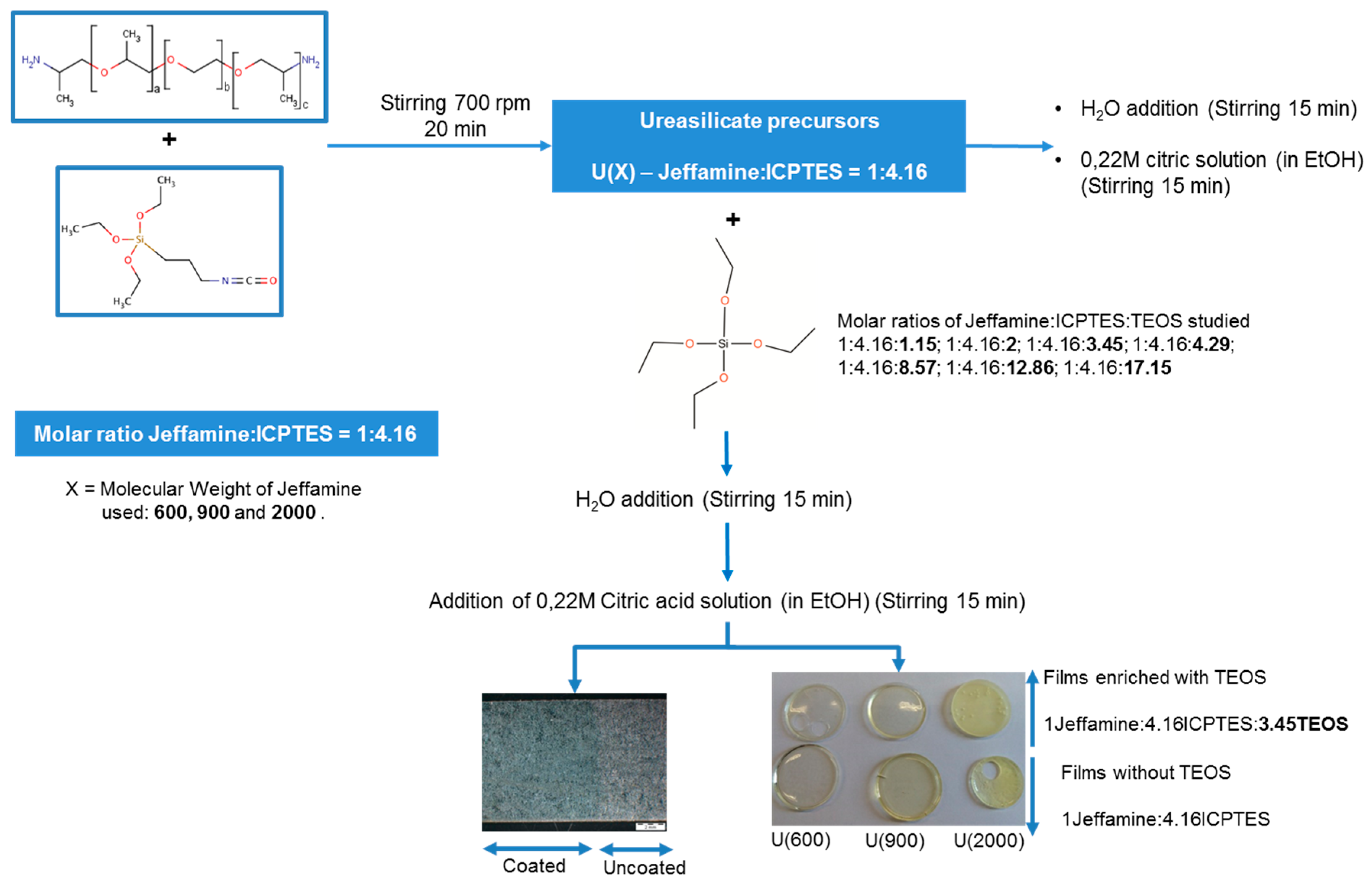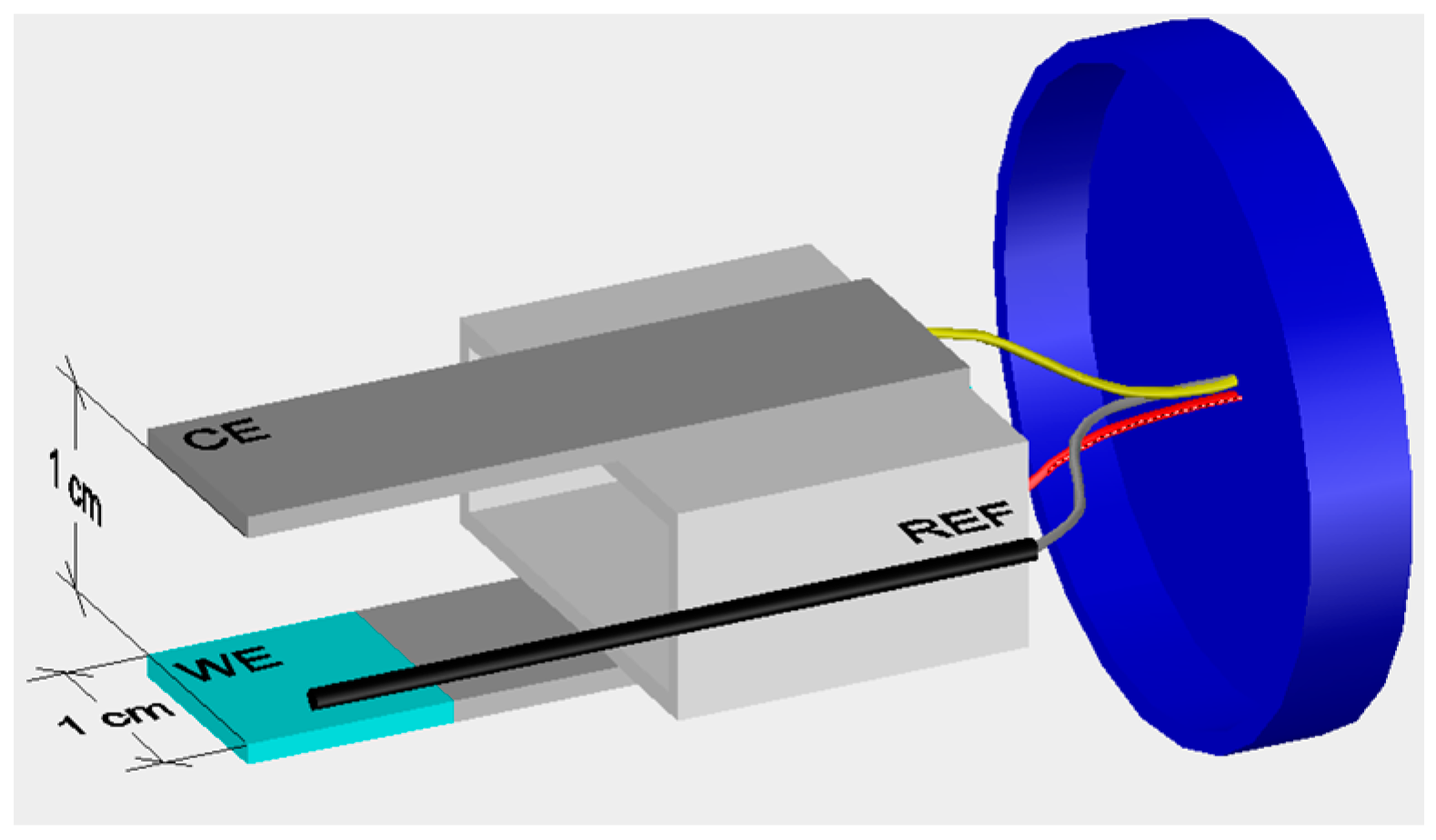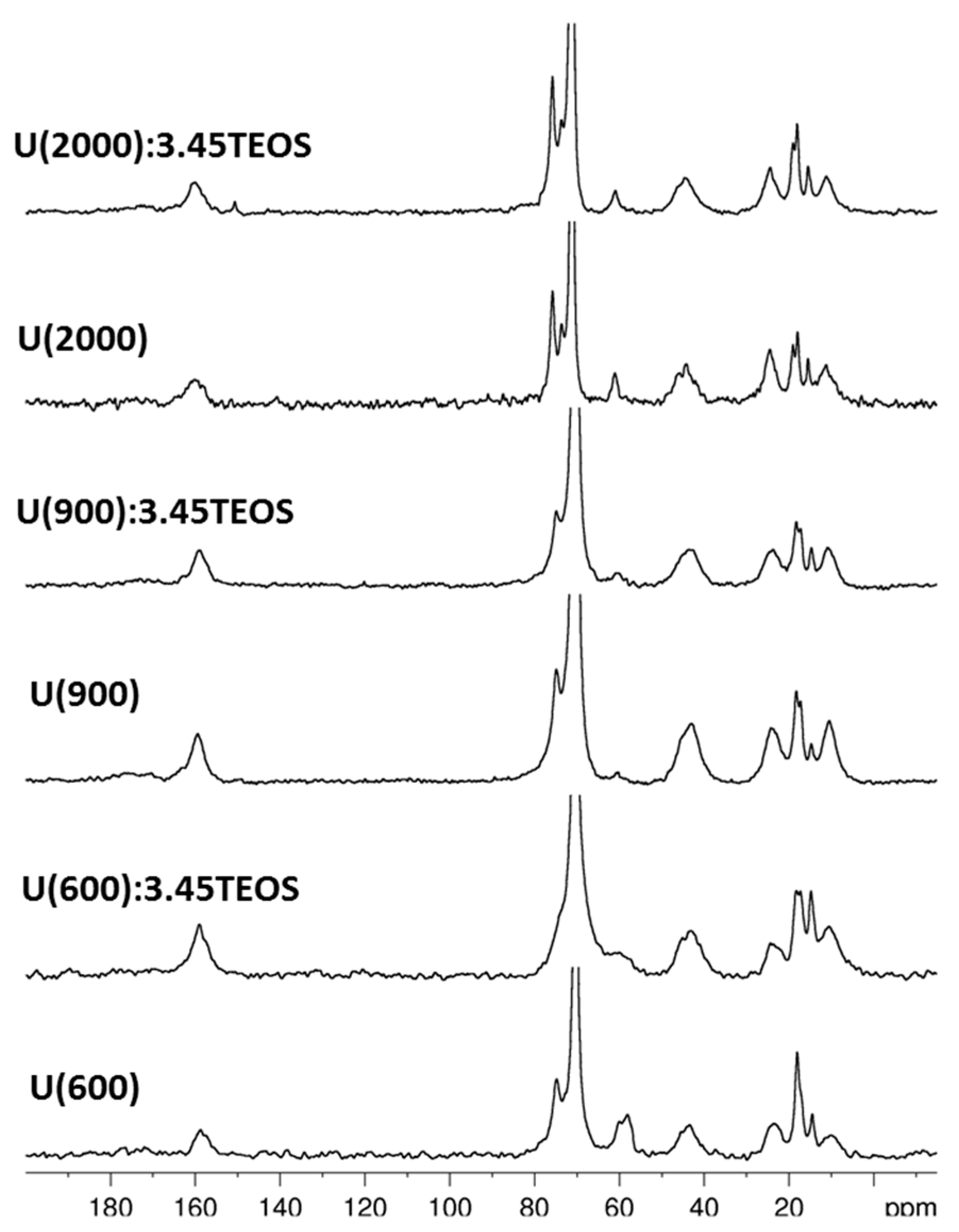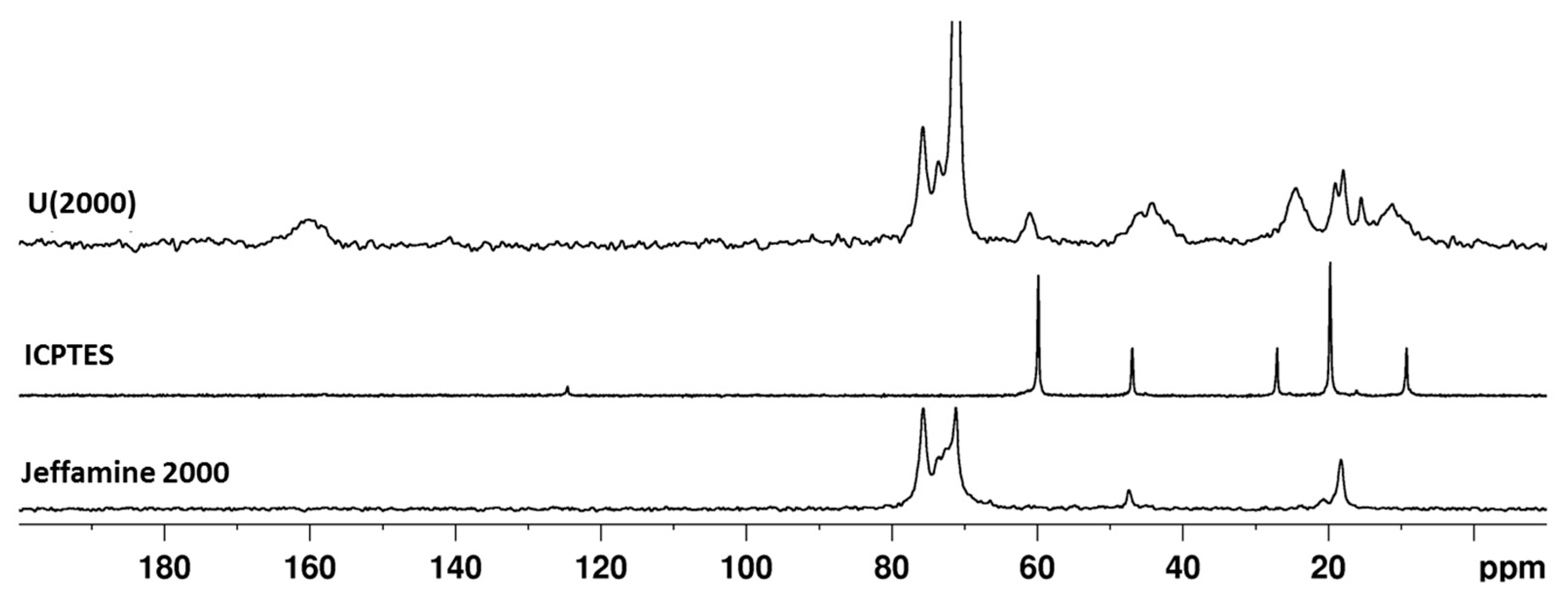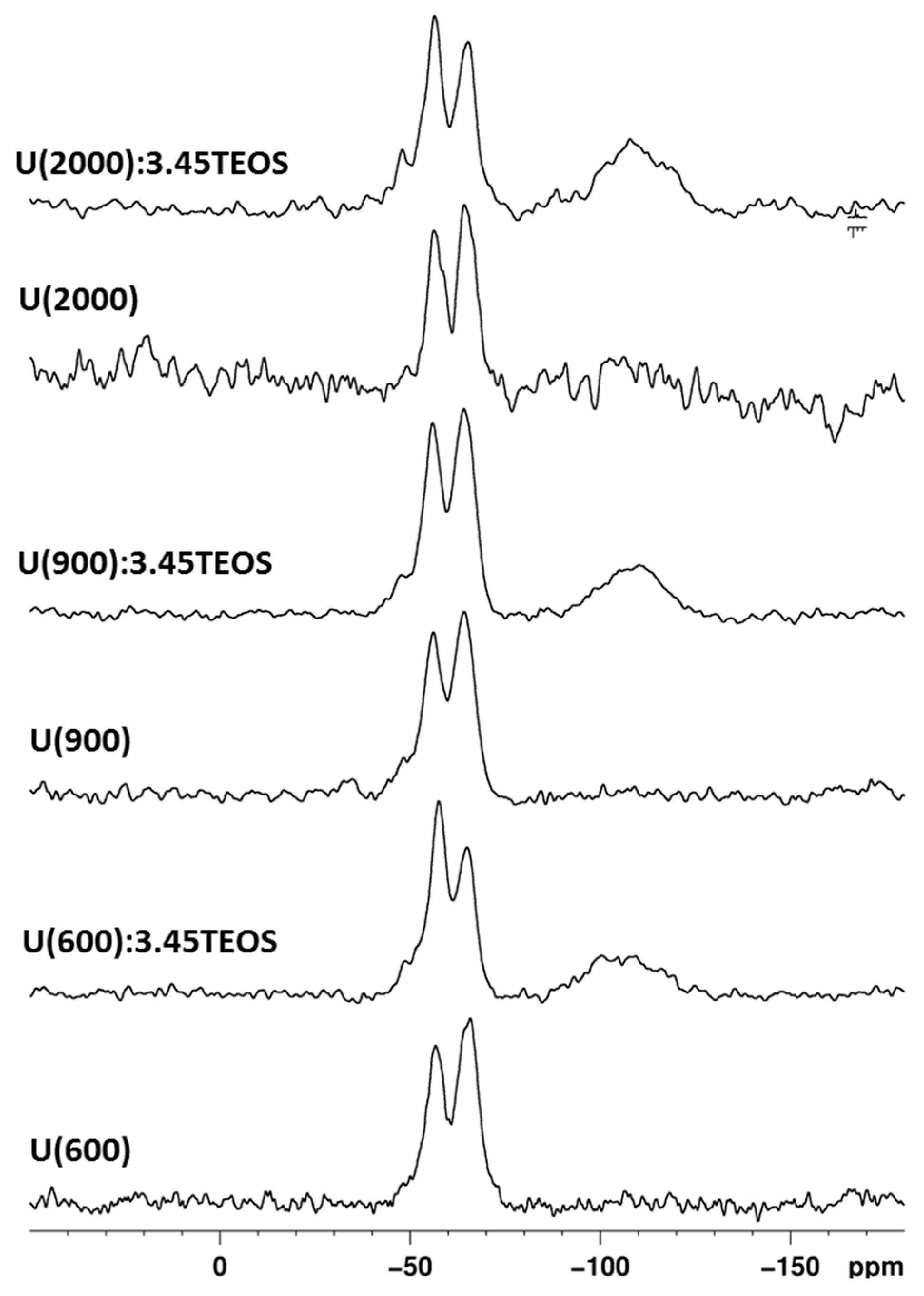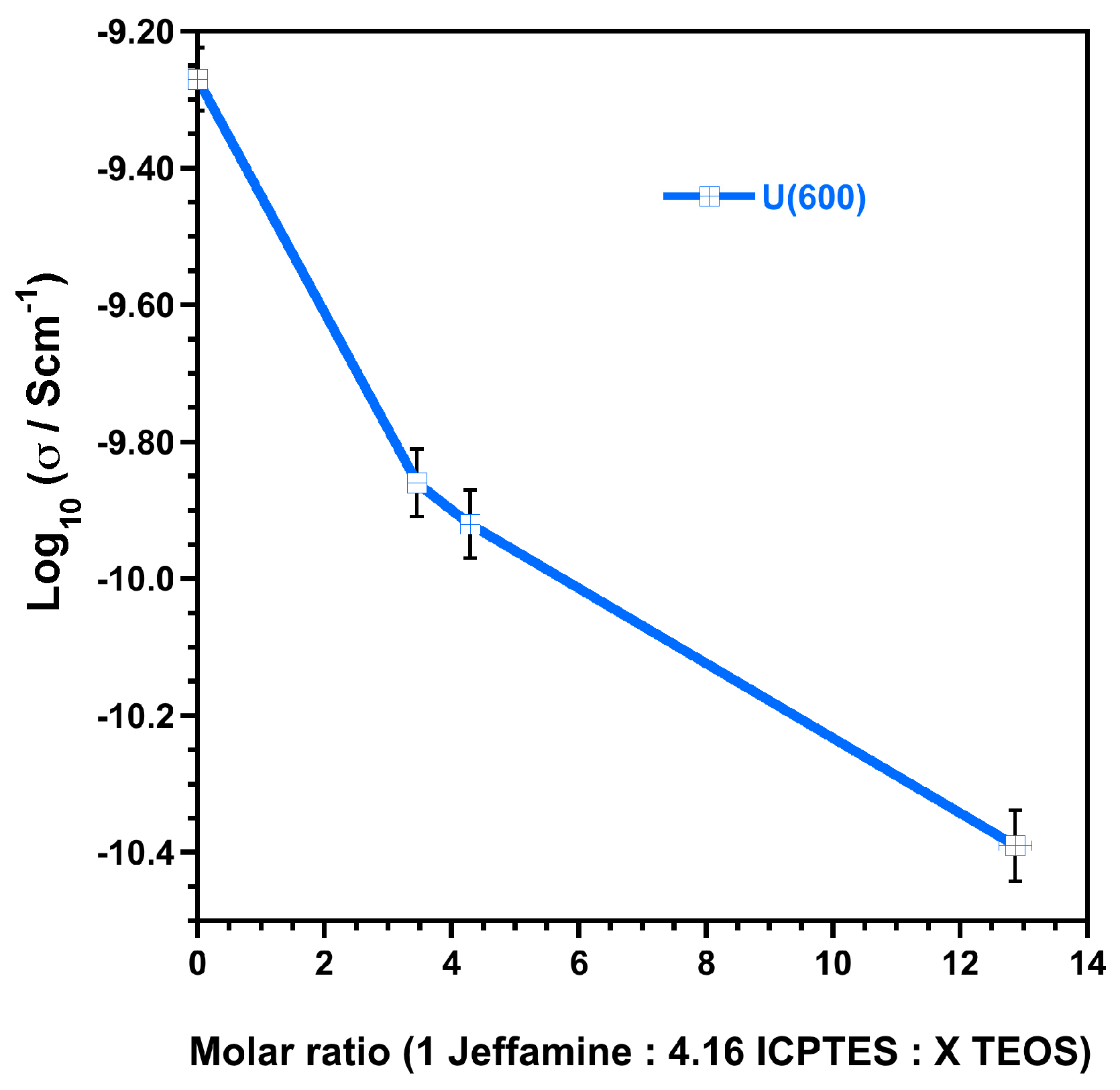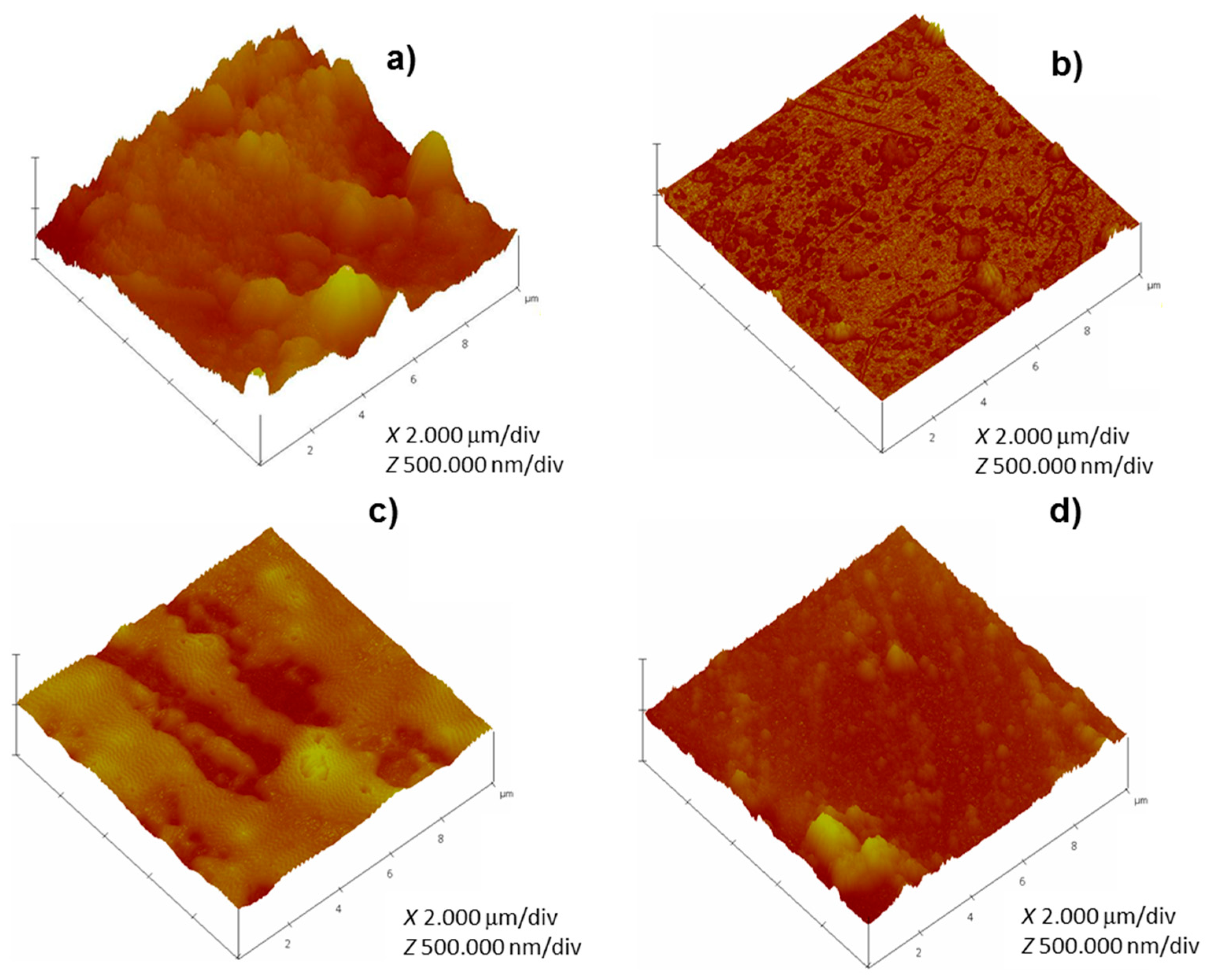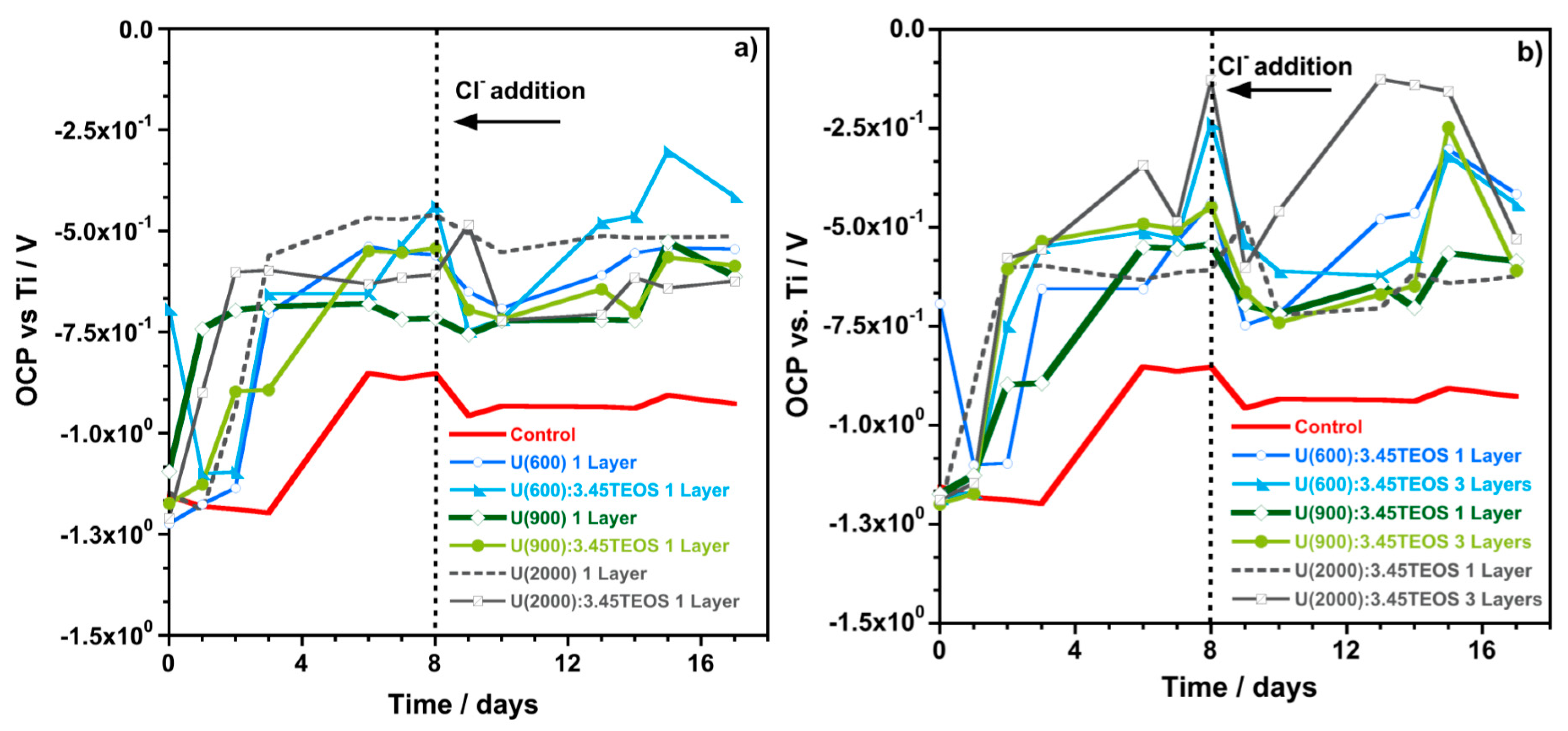3.1. NMR Analysis
Structural features of the hybrid materials were investigated by multinuclear solid state NMR. The
13C CPMAS spectra of the hybrid samples with and without TEOS are shown in
Figure 4 and the assignments of the signals are reported in
Table 2.
The final materials give rise to carbon spectra characterized by sharp peaks due to the mobile PPG/PEG chains of the Jeffamine
® molecules and broad peaks produced by the short organic chains and the unreacted alkoxide groups of the silane. The spectra of samples with and without TEOS result superimposable, suggesting the hydrolysis of the ethoxide groups belonging to the tetra-alkoxysilane.
Figure 5 reports the comparison among the spectra of Jeffamine
® 2000, ICPTES and the corresponding hybrid sample (U(2000)); since the pristine reagents are liquid, a small shift with respect to their signals in the solid state is expected. In the ICPTES spectrum, the peak attributed to the carbon atom in the isocyanate group (–N=C=O) is found at approximately 125 ppm. In the spectrum of the hybrid sample (U(2000) (
Figure 6), the absence of the N=C=O ICPTES peak and the broad signal at about 160 ppm clearly shows that the reaction between the polymer amino groups and the N=C=O end group of ICPTES took place.
Nevertheless, the broad resonance at 160 ppm cannot be attributed to a single component but appears to be the result of several overlapped signals. According to the molar ratio among the reagents (
Table 1), the amount of isocyanate groups is over-stoichiometric with respect to the Jeffamine terminal NH
2 groups and, potentially, only half of the N=C=O groups can react with the amino groups of the Jeffamine molecule. Therefore, the residual isocyanate groups may react with ethanol leading to the formation of the urethane function. For assessing this hypothesis, ICPTES and Jeffamine
® 600 (selected according to the lower viscosity) have been mixed in the NMR tube in 1:4.16 molar ratios with deuterated ethanol and the
13C-NMR spectra have been acquired on the solution just after mixing the reagents, after 24 h aging and with the addition of citric acid (
Figure S1, Supplementary Materials).
The
13C-NMR spectrum, recorded on the mixture immediately after mixing, shows a signal at 159 ppm and a less intense resonance at 157 ppm, respectively attributed to the –HNCONH– and –HNCOO-bridges [
51,
52] formed by reaction of the isocyanate groups of ICPTES. After 24 h, the decrease in intensity of the peak at 123 ppm due to N=C=O is clear, and the two resonances at 159 and 157 ppm present similar intensity. From these results, it can be concluded that both urea and urethane bridges are immediately created after the mixing of reagents. However, the formation of the –HNCONH– bridge is favored. It should be noted that the stoichiometric conditions used here caused the formation, during the aging process, of a valuable amount of urethane functions. The stability of the formed urea and urethane bridges has been evaluated by adding citric acid to the aged mixture. The carboxylic acid addition leads to the appearance in the spectrum of the carboxy groups signals at 170.4, 172.6 and 175.6 ppm, but does not affect the –HNCONH– and –HNCOO– signals, since the only variation is the increase of urethane groups by further isocyanate group consumption.
The quantitative analysis of the carbonyl band in the solid state
13C spectra of hybrid samples (
Figure 4) is limited by the unsatisfactory signal-to-noise ratio (S/N). In order to better point out the signal components in the range 150–170 ppm (
Figure 4), a
13C CPMAS spectrum was recorded on a selected sample with very high number of scans (10 k scans) and the profile fitting analysis was performed on the low-field part of the spectrum which presents more resolved signals and improved S/N (
Figure S2, Supplementary Materials). The carbonyl band appears to be the result of four overlapping signals, two intense resonances at 159 ppm (47%) and 157 ppm (26%) and two signals at 154 (16%) and 162 ppm (11%). The clear assignment of the latter components is still under investigation but, in agreement with a previous FTIR study pointing out the presence of several components in the amide band of ureasilicate samples [
53], that may be related to chains with different hydrogen bonding interactions.
A weak and broad resonance is also detected at about 172 ppm (
Figure S2, Supplementary Materials), which can be attributed to the carboxylate functions of citric acid in agreement with the NMR study in solution (
Figure S1, Supplementary Materials). The
13C spectra of hybrid samples (
Figure 4 and
Table 2) reveal the signals of residual ethoxyde groups suggesting that the organosilane hydrolysis is not complete in spite of the hydrolysis ratio used in the hybrid synthesis (
Table 1). The content of citric acid in the mixtures is about 10% with respect to the whole silane amount (
Table 1) and the complexation of the Si units by citric acid cannot be excluded, taking into account the well-known reactivity of carboxylic acids towards silicon alkoxides [
54].
In the hybrid samples (
Figure 4), the signals of PEG/PPG moieties appear unchanged when compared to the pristine Jeffamine
® molecules. The only exception is with Jeffamine
® 2000. The resonances at around 70–75 ppm change both in shape and intensity, when comparing the spectra of Jeffamine 2000 and U(2000) (
Figure 5). Since these signals are not related to reactive parts of the molecules, the conformation rearrangement of the chains in the hybrid could be responsible for peak changes. Previous observations on the evolution of the FTIR signal of oxyethylene chains [
53] pointed out that, in the hybrids, the chains partially lose the original helical conformation, acquiring a less ordered structure.
The
29Si NMR spectra were recorded on hybrid samples using both CP (
Figure S3, Supplementary Materials) and SP (
Figure 6) sequences; the Si units are labeled using the common NMR notation: Q
n and T
n are tetrafunctional SiO
4 and trifunctional SiCO
3 units, respectively and n is the number of siloxane bridges. The results of the profile fitting analysis of the
29Si MAS NMR spectra are reported in
Table 3.
The
29Si NMR spectra (
Figure 6) shows the typical signals of T units (−50 ÷ −70 ppm) due to ICPTES, and Q units (−90 ÷ −120 ppm) for samples prepared with TEOS addition. Hybrid samples prepared without TEOS addition show only T
2 and T
3 species. The degree of condensation (DOC) calculated according to the following equation [
55]:
is around 85% (
Table 3). With TEOS addition, the T region is characterized by the signals of T
1, T
2, and T
3 units, and the Q region presents the signals of Q
2, Q
3 and Q
4 units; generally, the DOC values are very similar to those of the samples prepared without TEOS (
Table 3). The
29Si NMR study confirms the reduced extent of hydrolysis-condensation of the sol-gel network as suggested by the
13C-NMR spectra.
The Q/T ratio reported in
Table 3 assesses the amount of TEOS incorporated into the hybrid networks. The calculated values are different from the nominal ones; only the sample prepared with high MW of Jeffamine
® shows an amount of Q units closer to the expected value (Q/T 0.8). In order to prove that the Q units were not underestimated as a consequence of the MAS experiment conditions, these results were validated acquiring the MAS spectra with increasing the relaxation time parameter.
Besides the Q/T ratio obtained by the quantitative analysis, the Q units are not clearly visible in the
29Si CPMAS spectra (
Figure S3, Supplementary Materials), contrariwise to CP spectra usually recorded with the same parameters on sol-gel hybrid organic/inorganic samples [
55]. Work is in progress to clarify this result, which indicates poor magnetization transfer efficiency in the CP experiments, resulting from large distances among protons and TEOS-derived units in the network. One possible explanation could be the segregation of Q domains as a consequence of TEOS complexation with citric acid. The resulting silicate units would belong to the Q units region but contribute to creating the large quantity of Q
3 and Q
2 units, thus decreasing the overall DOC (
Table 3).
3.3. Electrochemical Impedance Spectroscopy (EIS) Analysis
Figure 7 shows the Nyquist complex impedance plots obtained from the EIS analysis of the film samples, namely U(600), U(900) and U(2000) synthesized with a molar ratio of Jeffamine:ICPTES equal to 1:4.16. The electrical equivalent circuit (EEC) used to describe the observed impedance response of each hybrid is shown as an inset in each Nyquist plot.
Figure 8 shows representative examples of the Nyquist plots obtained for U(X) samples enriched with different ratios of TEOS, namely U(600):3.45TEOS, U(900):3.45TEOS and U(2000):3.45TEOS.
Figure 7 and
Figure 8 show that, at higher frequencies, a semicircle that intercepts the
x-axis is present in all the Nyquist plots. The amplitude of the semi-circles changes with the sample composition. This is assigned to the electric properties, such as conductivity and capacitance, of the hybrid films. Data obtained at lower frequencies describe a line suggesting another electrochemical process, which is attributed to the Au | hybrid film interface [
32]. The semicircles in the Nyquist plots (
Figure 7 and
Figure 8) show a depressed form, and so the analysis of all the impedance responses was based on EEC where constant phase elements (CPE) were used instead of pure capacitance. The impedance of a CPE is known by [
56]:
where α and Q represent parameters regardless of the frequency [
57]. When α = 1, Q represents the capacity (F/cm
2) while if α ≠ 1, Q has units of S
α/Ωcm
2 and the system shows a behavior that is linked to the surface heterogeneity [
57,
58,
59].
A resistive–capacitive parallel circuit was considered and the impedance for the EEC is given by [
57]:
R
Sample represents the resistance in parallel with the CPE. The CPE parameter Q cannot be equated to the interfacial capacitance (C
eff). Therefore, the C
eff was estimated using the relationship developed by Brug et al. [
57,
58]:
C
eff values were calculated according to Equation (4). Normalized resistance (R/Ω·cm
2), normalized capacitance (C/nF·cm
−2) and conductivity (σ/S·cm
−1) were also determined. The R and C values were normalized to cell geometry dimensions. The obtained values were calculated using the following equations (where A
Au is the area of the gold electrodes and d
Sample the thickness of the analyzed OIH film sample).
Only the electrochemical process at high frequencies was fitted and the EEC used to model the Nyquist plots for all the hybrid contain a simple CPE (Q/S
α Ω
−1·cm
−2) and a Resistance (R
sample/Ω·cm
2), which is associated to the hybrid film resistance. Five measurements were performed for each hybrid sample. However, only one representative example among the five measurements performed is shown (
Table 5). The obtained fitting parameters, namely R
Sample, Q (represented by CPE in the EEC) and α as well as the percentage of error associated to each element are presented in
Table 5. The data obtained at lower applied frequencies describe a line suggesting another electrochemical process. This process is assigned to Au|hybrid film interfacial phenomena and a simple R-C EEC describes this part of the Nyquist plot. However, the fitting was not executed since it was not relevant for the understanding of the electrochemical behavior of hybrid films. The solid lines in all the Nyquist plots correspond to the fitted regions. The behavior observed at the different frequency ranges is a consequence of capacitance time constants with large differences that are linked to the charge transport across the hybrid and the charge relaxation that occurs at the interfaces.
C
eff values were calculated according to Equation (4) and as described in previous publications [
32,
36,
60]. The resistance (R) and capacitance (C) values were normalized to cell geometry dimensions. The conductivity (σ/S·cm
−1) was also determined.
Table 6, shows the average values of the logarithm of resistance (log R), conductivity (−log σ), C and ε
r obtained for all the samples of each hybrid film (uncertainty is expressed for 95% confidence).
Figure 9 shows the average values of the conductivity (−log σ) (uncertainty is expressed for 95% confidence, (
Table 6)) obtained for the hybrid film samples prepared with Jeffamine with a MW of approximately 600 g·mol
−1 with different contents of TEOS (according to
Table 1).
The conductivity values obtained for the U(X) samples prepared with a molar ratio of Jeffamine:ICPTES = 1:4.16 are lower when compared to the data obtained for samples prepared with a molar ratio of Jeffamine:ICPTES = 1:2 [
32]. When TEOS is added,
Table 6 and
Figure 9 show that, as the content of TEOS increases, the conductivity keeps decreasing, the normalized R values increase and the ε
r decreases. Moreover, excepting for the hybrid films based on U(2000) matrices, the normalized R values obtained are all above 10
7 Ω·cm
2 (
Table 5), suggesting that these materials meet the necessary requirements to provide an effective corrosion protection [
61,
62].
The results show that the addition of TEOS to the hybrid matrices, which increases the inorganic component of the matrix and decreases the sol viscosity, improves the barrier properties of the ureasilicate matrices by increasing their resistance (and decreasing the conductivity); this evidence is in agreement with previous studies [
31,
37].
The capacitance is another parameter used for the characterization of the barrier protective properties. The values obtained for samples based on U(600) matrices (
Table 5) generally increase when the content of TEOS increases. However, for higher MWs of Jeffamine
® this tendency was not found. Samples based on U(900) and U(2000) matrices showed lower capacitances when the content of TEOS increased. EIS data evidence that the molecular size of organic (Jeffamine
®) component in the ureasilicate network has a major relevance on the dielectric properties. This emphasizes that the charge transport and relaxation processes occur predominantly across in the organic environment.
3.4. Atomic Force Microscopy (AFM)
The AFM analysis of the surface of HDGS coated samples were scanned on an area of 10 × 10 μm
2.
Figure 10 shows representative topographic images of samples coated with one layer of hybrid enriched with TEOS before immersion in SCPS.
As expected, coated samples displayed smoother surfaces compared to control (uncoated samples). Nevertheless, the coated surfaces were not uniform and the presence of defects was also detected (
Figure 10). The coating method deposition used, as well as the curing process, may explain the presence of these agglomerates and defects [
27,
33,
34]. The amplitude parameters used to characterize the topography of a surface are the average roughness (R
a) and the root mean square roughness (R
q).
Table 6 shows the values of R
q, R
a, and R
max (maximum vertical distance between the highest and lowest data points within a given area) for the control and HDGS-coated samples. As expected, control shows higher R
q values (above 100 nm) and coated samples show lower R
q values, below or equal to 46 nm for samples without TEOS and below or equal to 35 nm for samples enriched with TEOS.
Generally,
Table 7 shows that, as the MW of Jeffamine
® increases, the coating roughness (R
q) increases. The introduction of TEOS during the synthesis leads to coatings with lower R
q values. This effect is due, probably, to the decrease of the viscosity of the sol hybrid sols by TEOS addition, which allows improved distribution on the metallic substrate.
U(900) samples are an exception, as the samples prepared with TEOS showed higher Rq, Ra and Rq than samples prepared without TEOS. It is worth of noting that Rmax obtained for samples prepared with Jeffamine® of MW 2000 is very high, when compared to other samples (generally ≈ 3 times higher). Again this result can be related to the viscosity of the hybrid sols. Indeed, as the MW of Jeffamine® increases the viscosity of the sols increase. Accordingly, for samples prepared with Jeffamine® of MW ≈ 2000 g·mol−1, the high viscosity results in inefficient/poor sol distribution and leads to the formation of large agglomerates (defects). These defects present higher dimensions than the ones formed when MWs of Jeffamine® are used.
The coating quality and surface roughness play a role on the corrosion behavior of metallic materials. An increase in the surface roughness increases the pitting susceptibility and corrosion rate which is according to the literature [
63]. The AFM and the EIS results are in agreement and show that, generally, as the MW of Jeffamine
® increases, the roughness increases and the resistance of the hybrid coatings decreases which is also according to previous studies [
27]. This tendency remains, even when the samples are enriched with TEOS. The results indicate that the corrosion behavior is not only dependent on coating quality but also on roughness, and the results have shown that samples with poor corrosion protection have high roughness, which is consistent with data found in the literature [
27,
63,
64].
3.5. Open Circuit Potential (OCP) and Polarization Resistance (Rp) Measurements
The OCP and R
p measurements were performed daily. The information extracted from OCP results indicates either a low or high probability of corrosion occurrence but it does not provide information on the corrosion rate [
65,
66,
67]. The R
p measurements represent the instantaneous corrosion current density. These measurements allow to assess the condition of the embedded steel reinforcement related to its corrosion [
65].
Figure 11 shows the OCP values obtained for each sample. Generally, coated samples show an increase in the OCP variation over time and the values are always higher than those obtained for the control sample. This behavior indicates that coated samples have low probability of corrosion occurrence (higher OCP values) compared to control samples (lower OCP values). After chloride addition the initial drop in the OCP values can be observed in all cases followed by an increase over time for coated samples, whereas the control sample display almost constant OCP values. Again, the OCP results indicate that coated samples, even in the presence of chloride ions, have lower probability of corrosion occurrence compared to control samples.
Table 8 shows the R
p values obtained on the Days 1, 7, 9 and 16 of immersion. Generally, coated samples show an increase in the R
p values after seven days of immersion (
Table 8), whereas the control samples show a significant decrease. Furthermore, low R
p values were obtained for the control samples on Day 7 when compared to all the coated samples that showed higher R
p values (between 10
3 and 10
5 Ω·cm
2). The behavior displayed by the control samples is explained by the zinc corrosion process in alkaline environments [
16,
66,
67]. For high pH values, the passivation of the surface of the substrate is difficult to reach and Zn dissolution continues until all the zinc has been dissolved. After Cl
− addition a sharp decrease of R
p values was registered for control samples and samples coated with three layers. Nevertheless, the values remained above those obtained for control samples. Improved results (high R
p values) were obtained by coating HDGS with only one layer of U(900) with TEOS and U(600) with and without TEOS, even after Cl
− addition.
After sixteen days of immersion,
Table 8 shows that the R
p values of the control samples did not change significantly and are considerably lower than those measured for coated samples. The results indicate that, on Day 16, the instantaneous corrosion current density reported for control samples is much higher compared to the values obtained for samples coated with one or three layers of hybrid with or without TEOS. Samples coated with one layer of U(2000):3.45TEOS and U(600):3.45TEOS provided higher and poorer corrosion protection, respectively. Samples coated with three layers of U(600):3.45TEOS and U(900)3.45TEOS provided the highest and the poorest corrosion protection, respectively.
Generally, AFM and R
p data show that, by TEOS incorporation into the hybrid matrices, the samples show improved corrosion behavior and lower roughness values (R
a and R
q). This study also points out that the OCP, R
p and EIS results are generally in agreement and samples enriched with TEOS, regardless the MW of Jeffamine
® used, show improved results in terms of higher resistance values and improved corrosion behavior. A higher degree of crosslinking was expected for samples enriched with TEOS, which would explain the improvement of the corrosion behavior. On the contrary, the NMR study pointed out that the TEOS addition does not lead to relevant structural changes in the hybrid network. Therefore, the results suggest that the tetraalkoxysilane (TEOS) could have a role as a coupling agent, providing improved affinity between the organic component and the metallic substrate by means of the interaction between Si-OH and metal-OH (native oxide layer of HDGS) [
31]. Nevertheless, no further conclusions can be drawn.
